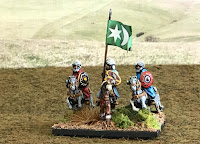Related Army Posts:
Abbasid Egyptians Mamluks Egyptians
You can download the banners from this army here:
You can download a card version of the tent here:
 |
| The Ayyubid Army with all the options |
The Ayyubid army provides the base from which I've created several armies, obviously the Ayyubids, plus the earlier Abbasids and the later Egyptian Mamluks (Posts to come). That is to say, not one army at all but a morphingly delicious melange.
 |
Al-Kamil (1177 - 1238) - The CinC.
|
 |
| L-R Alternative Armies, Irregular Miniatures, Grumpy Miniatures |
The famous Saladin founded the Kurdish Ayyubid dynasty which ruled large parts of the Middle East in the 12th & 13th centuries. Egypt became the leading Muslim state in the region.
 |
| The general with all the mamluk and ghulam cavalry |
 |
| Just the the mamluks and ghulams - Almost entirely Alternative Armies. Play spot the Irregular mini. |
Saladin and his successors were also patrons of the arts and sciences. The Ayyubids are remembered for both fighting against and negotiating with the Christian Crusaders.
 |
| The qaraghulam cavalry - Museum Miniatures with Irregular standard bearers |
The Sultanate decentralized after Saladin’s death, with his sons squabbling over succession. This proved to be a fundamental weakness when the Ayyubid dynasty ultimately fell to descendants of slaves to whom Saladin had allowed a greater measure of freedom, the Mamluks.
 |
| The light horse |
 |
| Turkoman horse archers - Irregular |
 |
| Bedouins - Museum |
As ever, I like to personalise my armies by attaching them to a specific general or ruler. Since I’ve made this army to pair against my later Crusaders, Lusignan Cypriots and Komnenan Byzantines, I’ve gone for Al-Kamil (1177 - 1238) as the Ayyubid leader that best fits this time frame.
 |
| Kurdish javelinmen (3Ax) who double up as glazes (3Wb) - Essex & Alternative Armies |
He was a nephew of Saladin and as Sultan of Egypt from 1218-1238, was therefore the most senior ruler in the Muslim Middle East.
 |
Cairo mob (5Hd)  |
He fought against the 5th Crusade, which targeted the Egyptian port city of Damietta, from 1217 - 1221. During this period al-Kamil made peace offers including the return of Jerusalem (offered twice) & rebuilding its walls. The Crusaders refused all offers and finally marched on Cairo eventually attacking al-Kamil’s fortified camp at Mansourah. As the Crusaders struggled to prosecute their attack, al-Kamil simply opened the dams and allowed the Nile to flood the Crusader attack. The Crusaders surrendered and accepted an eight-year peace.
 |
Syrian ahdath town militia (7Hd)  |
The 6th Crusade (1228-29) forced him to cede Jerusalem to the Crusaders. However although there was peace with the Crusaders, al-Kamil had to contend with the Seljuks and the Kwarizmians.
 |
| Sudanese archers (4Bw) - Alternative Armies |
The Ayyubid dynasty was to fall to the Mamluks in 1250, some 12 years after al-Kamil’s death.
 |
| Syrian Druze bowman (Ps) - Grumpy |
 |
The baggage camp - Alternative Armies camp guards   |
Featherstone Factor 39 - Ahead of the pack
If only just.
The name Saracen comes fro the Arabic ‘Sharkeyn’ - meaning ‘Eastern People.’ The armies of Islam were a rising tide that swept the Byzantines and the forces of Christianity from the Holy Lands. They had numbers, speed of attack and fervour in their favour. But something of lightweights compared to the western knights - if the Crusaders could ever catch them.












No comments:
Post a Comment